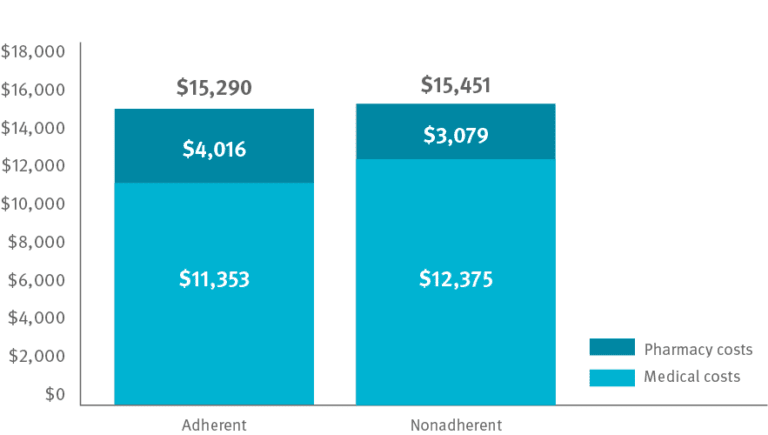Perspectives
Generic statin adherence associated with lower total cost of care
Two-year study of adherence shows lower total cost of care
March 27, 2018What was the study about?
Can improved adherence be linked to lower cost of care in the statin drug class? Previous analyses had shortcomings: for example, one looked solely at a retiree population; others took place before many of the current generic statins were available. This study looked at commercially insured members taking generic statins over a two-year period. We looked at:
- Adherence and nonadherence
- Hospitalization rates and emergency room (ER) events
- Pharmacy costs
- Medical costs
- Total cost of care
What did we learn?
This study showed that higher generic statin adherence was associated with lower hospitalization rates and fewer ER visits. Higher generic statin adherence led to higher pharmacy costs, but lower medical costs. The lower medical costs offset the higher pharmacy costs, resulting in total lower cost of care.
Methods
This study used integrated medical and pharmacy claims data from a Blue Cross Plan in the central U.S. with 1.2 million members. To be included in the study, members had to be continuously enrolled from Jan. 1, 2007 through Dec. 31, 2010. Members had to have two separate office visits or a hospitalization related to high cholesterol in 2008. Only those with at least 80 percent of their statin claims as generic were included. 22,000 members met inclusion and exclusion data.
Results
During the two-year follow up, 46 percent of members were adherent to their generic statin medications. 54 percent of members were nonadherent. (Proportion of days covered (PDC) ? 80 was used as the definition of adherent.
The adherent group was associated with a lower hospitalization rate (25 percent for adherent vs 27.6 percent for nonadherent). Medical costs, pharmacy costs and total cost of care are reflected in the chart below.
We knew about the lower hospitalization rate, but in the past, better adherence also came with a higher cost of care because of the high cost of brand-name statins. With more generic statins on the market, the higher pharmacy costs come down. The higher utilization – with generic statins – is associated with fewer hospitalizations. And it contributes to lower overall cost of care.
Total cost of care comparing adherence to generic statins

Conclusions
For members with high cholesterol, total cost of care was lower for the generic statin adherent group. The cost differences were the result of lower medical costs offsetting higher pharmacy costs. This is different than previous studies: possibly because the study group is younger and because of the primary use of generic statins.
Further research is needed to see if interventions to improve adherence will improve total cost of care.
What does this mean for you?
Increased adherence to statin drug therapy can help prevent hospitalizations. Adherence to generic statins was associated with lower overall health care costs.
GuidedHealth® has programs that can target members at high risk to improve adherence. Prime offers benefit design consultation that can improve generic utilization.
GuidedHealth is a registered trademark of Prime Therapeutics LLC.
Related news
Perspectives
July 25, 2024
Quarterly Drug Pipeline: July 2024
Clinical insights and competitive intelligence on anticipated drugs in development
Perspectives
July 22, 2024
Oncology Insights: 2024 ASCO Annual Meeting key findings
Findings from this year’s American Society of Clinical Oncology (ASCO) Annual Meeting will likely lead to clinical practice changes and U.S. Food and Drug Administration (FDA) drug approvals or expansions
Perspectives
July 16, 2024
LISTEN NOW: Beyond the business – Stories of corporate kindness | Pharmacy Friends Podcast
In this episode, we talk about how our employees' help goes beyond our work in health care, aiding in philanthropic efforts